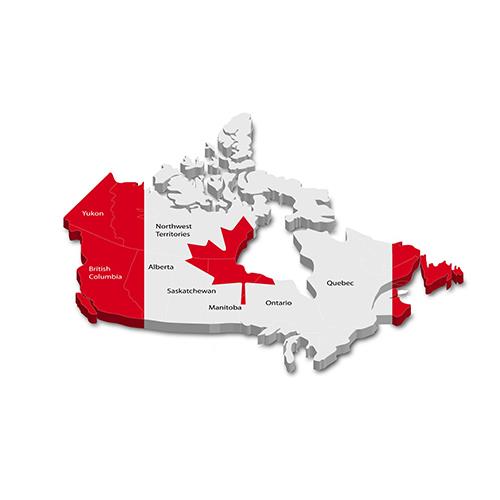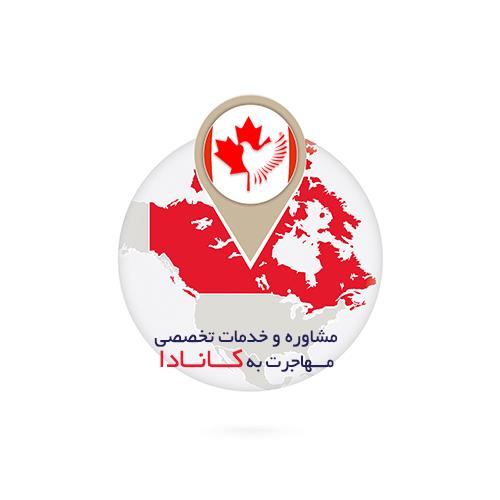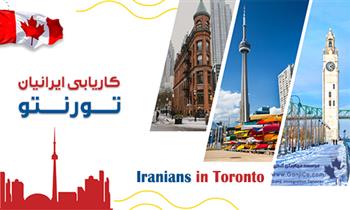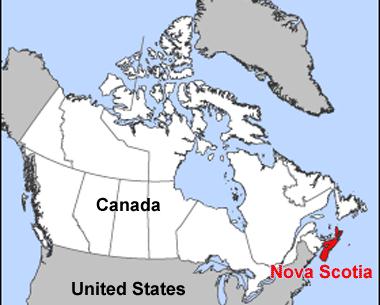
Nova Scotia-Halifax
Nova Scotia is one of Canada's three Maritime Provinces and one of the four Atlantic Canada provinces. Nova Scotia is the second-smallest province in Canada, with an area of 55,284 km2, including Cape Breton Island and another 3,800 coastal islands. As of 2011, the population was 921,727, making Nova Scotia the second less populated province in Canada. Its provincial capital is Halifax with a population of 390,096 in 2011.
Geography of Nova Scotia
Nova Scotia is Canada's third-smallest province in area after Prince Edward Island and New Brunswick. The province's mainland is the Nova Scotia peninsula surrounded by the Atlantic Ocean, including numerous bays and estuaries. It is attached to North America through the Isthmus of Chignecto. Various offshore islands, the largest of which is Cape Breton Island, form the bulk of the eastern part of the province.
Nova Scotia has a great variety of coastal landforms. Most of the land in Nova Scotia is bedrock. As a result of erosion and transportation of unconsolidated material, landforms such as beaches and marshes are being formed. These deposits are also being eroded and/or flooded by the rising sea level.
Nova Scotia's numerous hills, several low mountain ranges (the entire province is located within the Appalachian Mountains), lush river valleys, lakes and forests, windswept barrens, and a varied sea coast ranging from extremely rugged to broad sand beaches, can be attributed to these forces.
Climate of Nova Scotia
Nova Scotia located in the mid-temperate region, although it is almost surrounded by water, the climate is closer to continental than to maritime. The temperature extremes of the continental climate are moderated by constant temperature of the Atlantic Ocean. Nova Scotia is the warmest of the provinces in Canada.
According to Nova Scotia’s climate which is primarily influenced by the sea, its cold winters and warm summers are modified and generally moderated by ocean influences. The province is surrounded by four major bodies of water: the Gulf of Saint Lawrence to the north, the Bay of Fundy to the west, the Gulf of Maine to the southwest, and Atlantic Ocean to the east.
The main factors influencing Nova Scotia's climate are the effects of the westerly winds, the interaction between three main air masses which converge on the east coast, Nova Scotia's location on the routes of the major eastward-moving storms, the modifying influence of the sea.
Heavy ice build-up in the Gulf of Saint Lawrence makes winters colder in northern Nova Scotia. Because of the shallowness of the Gulf's waters, they warm up more than the Atlantic Ocean in the summer and warming the summers in northern Nova Scotia. Summer lasts from April to October. Although Nova Scotia has a somewhat moderated climate, there have been some very intense heatwaves and cold snaps recorded over the past 160 years. The highest temperature ever recorded in the province was 38.3 °C and the coldest temperature ever recorded was −41.1 °C.
The annual temperatures varies in spring from 1 °C to 17 °C, in summer from 14 °C to 28 °C, in Autumn about 5 °C to 20 °C and in Winter about −9 °C to 0 °C.
History of Nova Scotia
Nova Scotia was already home to the Mi'kmaq people when the first European, French, colonists arrived in 1604.They established the first permanent European settlement in Canada. The British conquest of Acadia took place in 1710. In 1749, the capital of Nova Scotia was changed from Annapolis Royal to Halifax.
The history of Nova Scotia was significantly influenced by the warfare that took place on its soil during the 17th and 18th centuries. There were nine significant battles as the English and Scottish, Dutch and French fought for possession of the colony.

During 19th century, Nova Scotia was the first colony in British North America and in the British Empire to achieve responsible government in January–February 1848 and become self-governing through the efforts of Joseph Howe. Nova Scotia had established representative government in 1758, an achievement that was later commemorated by erecting the Dingle Tower in 1908.
The American Revolution (1775–1783) had a significant impact on shaping Nova Scotia.
The origin of Nova Scotia’s name
Nova Scotia means New Scotland. In French it is called "Nouvelle-Écosse", which is a literal translation from Latin to French. In Scottish Gaelic, the province is called Alba Nuadh, which also simply means New Scotland. The province was first named in the 1621 Royal Charter granting the right to settle lands including modern Nova Scotia, Cape Breton Island, Prince Edward Island, New Brunswick, and the Gaspé Peninsula to Sir William Alexander in 1632.
Flag of Nova Scotia
The flag of Nova Scotia was created in 1858 and granted to the Scottish colony by Charles I, in 1625.
The flag of the modern Canadian province, a blue saltire on a white background, is a simple figure-ground reversal of the flag of Scotland (a white saltire, Saint Andrew's cross, on a blue field, charged with an inescutcheon bearing the royal arms of Scotland, a gold shield with a red lion rampant surrounded by a loyal double tressure.
The similarity to the Scottish flag reflects the province's name, which is Latin for "New Scotland". Nova Scotia was one of the few British colonies to be granted its own Coat of Arms, and the flag is the only one of the original Canadian provinces dating back to before confederation.
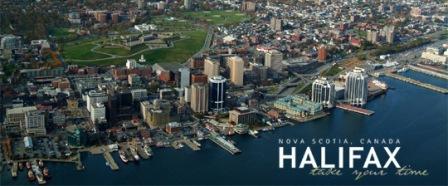
Official Language of Nova Scotia
English is the official language of Nova Scotia and is the language spoken by 92.46% of the population of the city. The province has a population of 921,727 in 2011.
Religion in Nova Scotia
Due to the 2001 census, the largest denominations by number of adherents were the Roman Catholic Church with 327,940 (37%); the United Church of Canada with 142,520 (17%); and the Anglican Church of Canada with 120,315 (13%).
Economy of Nova Scotia
In 2010 The Province Per capita GDP was $38,475, significantly lower than the national average per capita GDP of $47,605 and a little more than half that of Canada's richest province, Alberta.
The fishery was pillar of the economy since its development as part of the economy of New France in the 17th century; however, the fishery suffered a sharp decline due to overfishing in the late 20th century. The collapse of the cod stocks and the closure of this sector resulted in a loss of approximately 20,000 jobs in 1992. Other sectors in the province were also hit hard, particularly during the last two decades: coal mining in Cape Breton and northern mainland Nova Scotia has virtually ceased production, and a large steel mill in Sydney closed during the 1990s. More recently, the high value of the Canadian dollar relative to the U.S. dollar has hurt the forestry industry, leading to the shutdown of a long-running pulp and paper mill near Liverpool. Mining, especially of gypsum and salt and to a lesser extent silica, peat and barite, is also a significant sector. Since 1991, offshore oil and gas has become an increasingly important part of the economy, although production and revenue are now declining. Agriculture remains an important sector in the province, particularly in the Annapolis Valley.
Nova Scotia’s defense and aerospace sector generates approximately $500 million in revenues and contributes about $1.5 billion to the provincial economy annually. To date, 40% of Canada’s military assets reside in Nova Scotia. Nova Scotia has the fourth-largest film industry in Canada hosting over 100 productions yearly, more than half of which are the products of international film and television producers.
Though only the second smallest province in Canada, Nova Scotia is a recognized exporter. The province is the world’s largest exporter of Christmas trees, lobster, gypsum, and wild berries. The province also boasts a rapidly developing Information & Communication Technology (ICT) sector which consists of over 500 companies, and employs roughly 15,000 people.
Tourism in Nova Scotia
The Nova Scotia tourism industry includes more than 6,500 direct businesses, supporting nearly 40,000 jobs. 200,000 cruise ship passengers from around the world flow through the Port of Halifax, Nova Scotia each year. This industry contributes approximately $1.3 billion annually to the economy.
Nova Scotia has many museums reflecting its ethnic heritage, including the Glooscap Heritage Centre, Grand-Pré National Historic Site, Hector Heritage Quay and the Black Cultural Centre for Nova Scotia. Others museums tell the story of its working history, such as the Cape Breton Miners' Museum, and the Maritime Museum of the Atlantic.
Nova Scotia has two national parks, Kejimkujik and Cape Breton Highlands, and many other protected areas. The Bay of Fundy has the highest tidal range in the world, and the iconic Peggys Cove is internationally recognized and receives 600,000 plus visitors a year.
Culture of Nova Scotia
Nova Scotia has long been a center for artistic and cultural excellence. The capital, Halifax, hosts institutions such as Nova Scotia College of Art and Design University, Art Gallery of Nova Scotia, Neptune Theatre, Two Planks and a Passion Theatre, Ship's Company Theatre and the Symphony Nova Scotia. The province is home to avant-garde visual art and traditional crafting, writing and publishing and a film industry.
Much of the historic public art sculptures in the province were made by the renowned New York sculptor J. Massey Rhind as well as Canadian sculptors Hamilton MacCarthy, George Hill, Emanuel Hahn and Louis-Philippe Hébert. Some of this public art was also created by internationally renowned Nova Scotian John Wilson (sculptor). Nova Scotian George Lang was a stone sculptor who also built many landmark buildings in the province; perhaps most notably he created the Welsford-Parker Monument.
Some of the province's greatest painters were William Valentine, Maria Morris, Jack L. Gray, Mabel Killiam Day, Ernest Lawson, Frances Bannerman, Alex Colville, Tom Forrestall and ship portrait artist John O'Brien.
Nova Scotia has produced numerous film actors. Academy Award nominee Ellen Page (Juno, Inception) lives in Nova Scotia; five time Academy Award nominee Arthur Kennedy called Nova Scotia his home; and two time Golden Globe winner Donald Sutherland spent most of his youth in the province. Nova Scotia has produced numerous musicians. The Grammy Award winners include Denny Doherty (from The Mamas & the Papas), Anne Murray, and Sarah McLachlan.
Education in Nova Scotia
Nova Scotia has more than 450 public schools for children. The public system offers primary to Grade 12. There are also private schools in the province. Public education is administered by seven regional school boards, responsible primarily for English instruction and French immersion. In Canada, education is the responsibility of the provinces and there is no Canadian federal ministry governing education. Nova Scotia has a population of less than one million people, but is home to eleven public universities and the Nova Scotia Community College, which offers programs at 13 locations. Six of the 11 universities – the Atlantic School of Theology, Dalhousie University, Mount Saint Vincent University, the NSCAD University, Saint Mary's University, and the University of King's College – are located in the Halifax Regional Municipality, which is the capital of Nova Scotia and the largest urban area in the Atlantic Canada region. The oldest university in the province is the University of King's College, established in 1789, and the newest university is Cape Breton University, established in 1974. In 2010-2011, Nova Scotia had 36,458 full-time and 7,394 part-time students.
Government of Nova Scotia
Nova Scotia is ordered by a parliamentary government within the construct of constitutional monarchy; the monarchy in Nova Scotia is the foundation of the executive, legislative, and judicial branches. The monarch is Queen Elizabeth II, who also serves as head of state of 15 other Commonwealth countries, each of Canada's nine other provinces, and the Canadian federal realm, and resides predominantly in the United Kingdom. As such, the Queen's representative, the Lieutenant Governor of Nova Scotia (presently John James Grant), carries out most of the royal duties in Nova Scotia.
Each of the 51 Members of the Legislative Assembly in the House of Assembly is elected by single member plurality in an electoral district or riding. General elections must be called by the lieutenant governor on the advice of the premier, or may be triggered by the government losing a confidence vote in the House. There are three dominant political parties in Nova Scotia: the Liberal Party, the New Democratic Party, and the Progressive Conservative Party.
The province's revenue comes mainly from the taxation of personal and corporate income, although taxes on tobacco and alcohol, its stake in the Atlantic Lottery Corporation, and oil and gas royalties are also significant.



